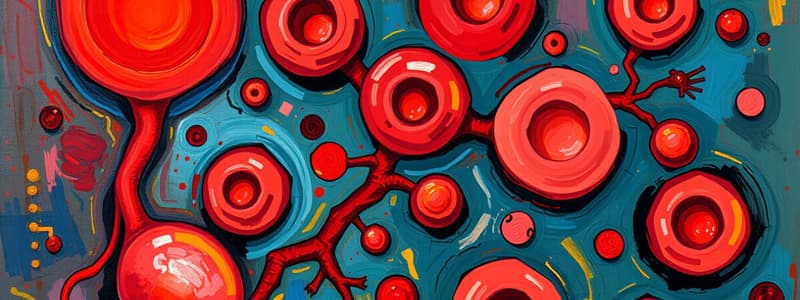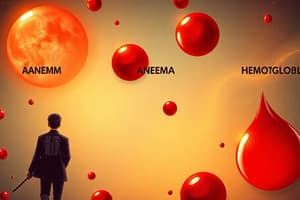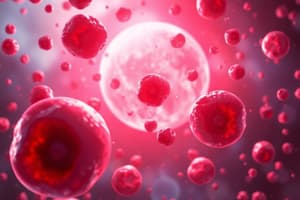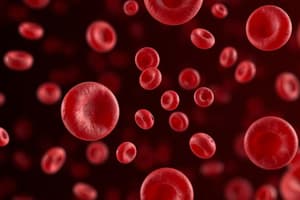Podcast
Questions and Answers
What is a characteristic of macrocytic, normochromic anemia?
What is a characteristic of macrocytic, normochromic anemia?
- Increased mean corpuscular volume (MCV) (correct)
- Decreased mean corpuscular hemoglobin concentration (MCHC)
- Decreased red blood cell lifespan
- Increased hemoglobin concentration in RBCs
Which of the following is a potential consequence of a diet lacking in vitamin B12 and folic acid?
Which of the following is a potential consequence of a diet lacking in vitamin B12 and folic acid?
- Increased absorption of oxygen by RBCs
- Development of larger and defective RBCs (correct)
- Formation of normal-sized mature RBCs
- Reduction of overall hemoglobin concentration in RBCs
What effect does polycythemia have on RBCs?
What effect does polycythemia have on RBCs?
- Decreases overall hemoglobin levels
- Increases the average size of RBCs
- Compromises the flexibility and lifespan of RBCs (correct)
- Enhances the oxygen carrying capacity of RBCs significantly
Why might a patient with a medical condition affecting vitamin absorption develop anemia?
Why might a patient with a medical condition affecting vitamin absorption develop anemia?
How much hemoglobin can RBCs concentrate in their cell fluid?
How much hemoglobin can RBCs concentrate in their cell fluid?
What is the consequence of folic acid deficiency in the context of hemoglobin?
What is the consequence of folic acid deficiency in the context of hemoglobin?
Which foods are particularly rich in folic acid?
Which foods are particularly rich in folic acid?
How many oxygen molecules can be transported by each hemoglobin molecule?
How many oxygen molecules can be transported by each hemoglobin molecule?
What is the average total quantity of iron in the human body?
What is the average total quantity of iron in the human body?
What condition may lead to serious difficulty in absorbing folic acid?
What condition may lead to serious difficulty in absorbing folic acid?
What characterizes hypochromic red blood cells in terms of MCH and MCHC?
What characterizes hypochromic red blood cells in terms of MCH and MCHC?
What typically happens after rapid hemorrhage in terms of red blood cell recovery?
What typically happens after rapid hemorrhage in terms of red blood cell recovery?
In hemolytic anemia, what impact does fragility of red blood cells have?
In hemolytic anemia, what impact does fragility of red blood cells have?
What is a key feature of chronic blood loss anemia?
What is a key feature of chronic blood loss anemia?
How does hemolytic anemia affect the shape of red blood cells?
How does hemolytic anemia affect the shape of red blood cells?
In which situation can blood loss anemia lead to rapid recovery of red cell concentration?
In which situation can blood loss anemia lead to rapid recovery of red cell concentration?
What immediate physiological response occurs after a rapid hemorrhage?
What immediate physiological response occurs after a rapid hemorrhage?
What contributes to the short lifespan of red blood cells in hemolytic anemia?
What contributes to the short lifespan of red blood cells in hemolytic anemia?
What characteristic skin appearance is commonly observed in individuals with polycythemia vera?
What characteristic skin appearance is commonly observed in individuals with polycythemia vera?
What is a potential physiological response of blood-forming organs in response to hypoxia?
What is a potential physiological response of blood-forming organs in response to hypoxia?
At what RBC count range is secondary polycythemia typically observed?
At what RBC count range is secondary polycythemia typically observed?
Which of the following conditions commonly leads to secondary polycythemia?
Which of the following conditions commonly leads to secondary polycythemia?
The bluish tint to the skin in polycythemia is primarily due to the presence of what type of hemoglobin?
The bluish tint to the skin in polycythemia is primarily due to the presence of what type of hemoglobin?
What is typically not associated with secondary polycythemia?
What is typically not associated with secondary polycythemia?
Which statement accurately reflects a potential cause of secondary polycythemia?
Which statement accurately reflects a potential cause of secondary polycythemia?
What effect does chronic hypoxia have on red blood cell production?
What effect does chronic hypoxia have on red blood cell production?
What is hemosiderosis primarily characterized by?
What is hemosiderosis primarily characterized by?
What happens when iron levels in plasma fall?
What happens when iron levels in plasma fall?
Which condition can lead to the presentation of jaundice due to hemolysis?
Which condition can lead to the presentation of jaundice due to hemolysis?
What is the role of transferrin in the context of erythroblasts?
What is the role of transferrin in the context of erythroblasts?
What distinguishes indirect bilirubin from direct bilirubin?
What distinguishes indirect bilirubin from direct bilirubin?
What can cause direct hyperbilirubinemia?
What can cause direct hyperbilirubinemia?
What characterizes indirect type hyperbilirubinemia?
What characterizes indirect type hyperbilirubinemia?
What mechanism allows erythroblasts to uptake transferrin-bound iron?
What mechanism allows erythroblasts to uptake transferrin-bound iron?
Flashcards are hidden until you start studying
Study Notes
Destruction of Hemoglobin
- Vitamin B12 and folic acid deficiencies can lead to ineffective absorption, resulting in larger and irregularly shaped red blood cells (RBCs).
- Defective RBCs maintain normal oxygen-carrying capacity but have compromised flexibility, leading to a shorter lifespan.
Types of Anemias
- Macrocytic, normochromic anemia is characterized by increased Mean Corpuscular Volume (MCV) and normal Mean Corpuscular Hemoglobin Concentration (MCHC).
- Hemolytic anemia can be hereditary or acquired and is marked by fragile red blood cells that rupture easily, especially when passing through the spleen.
Iron Metabolism
- The body contains an average of 4 to 5 grams of iron, which is crucial for hemoglobin function.
- Hemoglobin molecules have four iron atoms, binding with oxygen molecules to facilitate transport.
- Jaundice can occur in severe anemia cases due to excess bilirubin from hemolysis, not attributable to liver dysfunction.
Quantity of Hemoglobin in Cells
- RBCs can concentrate hemoglobin up to 34 grams per 100 milliliters of cells.
- Low MCH and MCHC indicate hypochromic anemia, while normal values indicate normochromic conditions.
- Inadequate transferrin levels prevent proper erythroblast proliferation, resulting in fewer normal RBCs and increased numbers of oversized or abnormal cells.
Types of Polycythemia
- Primary polycythemia vera leads to a ruddy complexion with a bluish tint due to deoxygenation.
- Secondary polycythemia arises from hypoxic conditions, causing increased RBC production, particularly in high altitudes or cardiac failure situations.
Test Your Knowledge
- Idiopathic aplastic anemia can be due to various factors, including drug reactions, benzene exposure, inherited mutations, or unknown causes.
- Hepcidin is produced in the liver, playing a role in iron metabolism and homeostasis.
Studying That Suits You
Use AI to generate personalized quizzes and flashcards to suit your learning preferences.




